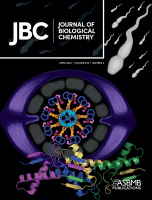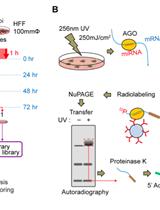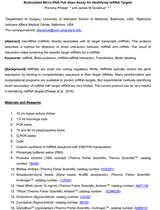- EN - English
- CN - 中文
Synthesis of Novel MicroRNA-30c Analogs to Reduce Apolipoprotein B Secretion in Human Hepatoma Cells
合成新型 MicroRNA-30c 类似物以减少人肝癌细胞中载脂蛋白 B 的分泌
发布: 2022年12月20日第12卷第24期 DOI: 10.21769/BioProtoc.4574 浏览次数: 2311
评审: Chiara AmbrogioMatthew SwireAnonymous reviewer(s)
Abstract
Atherosclerosis, a condition characterized by thickening of the arteries due to lipid deposition, is the major contributor to and hallmark of cardiovascular disease. Although great progress has been made in lowering the lipid plaques in patients, the conventional therapies fail to address the needs of those that are intolerant or non-responsive to the treatment. Therefore, additional novel therapeutic approaches are warranted. We have previously shown that increasing the cellular amounts of microRNA-30c (miR-30c) with the aid of viral vectors or liposomes can successfully reduce plasma cholesterol and atherosclerosis in mice. To avoid the use of viruses and liposomes, we have developed new methods to synthesize novel miR-30c analogs with increasing potency and efficacy, including 2’-O-methyl (2’OMe), 2’-fluoro (2’F), pseudouridine (ᴪ), phosphorothioate (PS), and N-acetylgalactosamine (GalNAc). The discovery of these modifications has profoundly impacted the modern RNA therapeutics, as evidenced by their increased nuclease stability and reduction in immune responses. We show that modifications on the passenger strand of miR-30c not only stabilize the duplex but also aid in a more readily uptake by the cells without the aid of viral vectors or lipid emulsions. After uptake, the analogs with PS linkages and GalNAc-modified ribonucleotides significantly reduce the secretion of apolipoprotein B (ApoB) without affecting apolipoprotein A1 (ApoA1) in human hepatoma Huh-7 cells. We envision an enormous potential for these modified miR-30c analogs in therapeutic intervention for treating cardiovascular diseases.
Keywords: Lipids (脂质)Background
Atherosclerosis, the aggregation of fibrofatty plaques in the artery wall, has been implicated in the pathogenesis of cardiovascular diseases with high morbidity and mortality rates in the United States and worldwide. High levels of plasma cholesterol is a risk factor leading to myocardial infarctions and strokes. Cholesterol is insoluble and, therefore, is packaged into lipoproteins for transport and delivery. As the major carriers, lipoproteins consist of fatty components such as free cholesterol, triglycerides, and phospholipids, enclosed by apolipoproteins (Apo) on the surface (Jialal and BartonDuell, 2016). These serum lipoproteins, synthesized in the liver, mainly include apolipoprotein A1 (ApoA1) and apolipoprotein B (ApoB). Aside from endogenous lipids production, the liver is also a key player in lipid metabolism (Yan et al., 2019). Abnormal lipid metabolism is one of the most important indications of cancer cell formation (Liu et al., 2017). Hepatocellular carcinoma (HCC), the most common form of liver cancer, accounts for approximately 80%–90% of all liver cancer types diagnosed worldwide. Studies have found that the ApoA1 level was substantially higher in curative resection HCC patients with overall improved survival. This suggested that ApoA1 can inhibit tumor proliferation and induce apoptosis, possibly by the mitogen-activated protein kinase (MAPK) pathway (Ma et al., 2016). Moreover, another study noticed that elevated ApoB is an alarming sign of tumor size greater than 5 cm at diagnosis and is associated with poor prognosis in HCC patients (Yan et al., 2019). Taken together, these findings indicate that both ApoA1 and ApoB are potential biomarkers for prognosis in post-surgery HCC patients. Additionally, ApoB is the main driver in atherogenesis, as it is the primary transporter for low density lipoprotein (LDL) (Libby et al., 2019). On the other hand, ApoA1 is a constituent of high density lipoprotein, known as the good cholesterol, playing a role in the elimination of excess cholesterol from peripheral tissues by the process of reverse cholesterol transport to the liver (Frank and Marcel, 2000). Deregulation in LDL cholesterol levels has also been linked to risk of myocardial infarction and cardiovascular disease (Mortensen and Nordestgaard, 2020).
Statins and proprotein convertase subtilis/kexin type 9 inhibitors (PCSK9) lower the plasma levels of low-density lipoprotein cholesterol (LDL-C) in hyperlipidemia and hypercholesterolemia patients (Blumenthal, 2000; Stoekenbroek et al., 2015); however, roughly 1–2 out of 10 patients develop statin intolerance with adverse symptoms (Ahmad, 2014). Moreover, cholesterol absorption inhibitors are ineffective in patients with genetic conditions caused by loss-of-function mutations in the LDL receptor or gain-of-function mutations in PCSK9, making homozygous familial hypercholesterolemia (FH) especially challenging to treat (Rader and Kastelein, 2014). Therefore, there is a need for more robust therapies that would encompass FH patients with lifelong drug durability. Additional approaches could involve reducing assembly and secretion of ApoB-containing lipoproteins. Biosynthesis of lipoproteins requires two components: a chaperone protein, the microsomal triglyceride transfer protein (MTP), and a structural protein, the ApoB. Both of these proteins are target candidates for therapeutic intervention in treating premature coronary diseases (Hussain and Bakillah, 2008). Lomitapide, a MTP inhibitor, is the current available therapy for patients with FH; however, this drug is known to cause hepatic steatosis and increase plasma transaminases, markers of liver injury (Rizzo and Wierzbicki, 2011). Hence, new avenues must be considered to reduce plasma LDL-C levels.
MicroRNAs (miRs) are short, non-coding RNA species, approximately 22–23 nucleotides in length that regulate gene expression post transcriptionally (Bartel, 2009). miRs are also known to be involved in various biological processes of cancerous cells, such as cell cycle and apoptosis, and were therefore further defined as either proto-oncogenes or tumor suppressors (Gong et al., 2015). The overexpression of tumor suppressor miRs can be used as a gene silencing tool that inhibits cell proliferation and metastasis, which ultimately leads to tumor cells arrest (Khare et al., 2013).
MiRs interact with the 3′-untranslated regions of target mRNAs by base pair complementarity to signal for their degradation and/or translational repression (Iwakawa and Tomari, 2015). Since their discovery, miR therapeutics have been an area of active research for their potential in treating different diseases. However, these developments have encountered difficulties. Chemical modifications result in loss of potency. Safe and targeted delivery is also challenging (Rupaimoole and Slack, 2017). To address these shortcomings, we synthesized an azido-modified N-acetylgalactosamine (GalNAc) moiety (GalNAcαProN3) that can be attached to any position of the RNA oligonucleotide modified with an alkyne group. In addition, phosphorothioate linkages were also introduced for the best action. Of course, this design could be extended to other miR systems, such as miR-122, which has been shown to inhibit growth and proliferation of HepG2 cells (Li et al., 2018). In our study, miR-30c was the best candidate in lowering plasma lipids and testing the effect on cell penetrating capacity when modifying the passenger strand. MiR-30c is a short, double-stranded non-coding RNA that belongs to the miR-30 family (miR-30a-e), highly conserved in the seed sequence (Irani and Hussain, 2015). We have previously reported that miR-30c interacts with the 3′-untranslated region of the MTP mRNA, leading to mRNA degradation and thereby reducing the secretion of apolipoprotein B by liver cells (JamesSoh, 2018. The successful synthesis of modified miR-30c passenger analogs with increased duplex stability and enhanced uptake by hepatoma cells, resulting in significant ApoB reductions without affecting the level of ApoA1(Yadav et al., 2022), have proven the feasibility of this approach. By introducing GalNAc residues at either end, we eliminated the need for lipid emulsion delivery as it might be more cost effective. Here, we detail the synthesis of modified miR-30c analogs. We envision this approach to be versatile as it can be applied to any tumor suppressor miR systems, to facilitate the development of their analogs as possible therapeutic drugs for lipid-lowering therapies and for the treatment of other diseases.
Materials and Reagents
U-shape cell culture flask, canted neck, 75 cm2 (Corning, catalog number: 430641U)
96-well ELISA plates (Fisher Scientific, Corning, catalog number: 07-200-640)
6-well plate (Fisher Scientific, Corning, catalog number: 07-200-80)
PrecisionGlideTM 25G needle (BD, catalog number: 305125)
Thin layer chromatography (TLC) plates pre-coated with silica gel F254 (Sigma-Aldrich, catalog number: 717185)
WatersTM Corp Sep-Pak C18 3 cc Vac cartridge (Fisher Scientific, catalog number: 50785823)
Protected RNA phosphoramidites [ChemGenes, catalog numbers: ANP-5671 (rA-CE), ANP-5673 (rG-CE), ANP-6676 (Ac-rC-CE), and ANP-5674 (rU-CE)]
Oligonucleotide synthesizer empty column (Alibaba, catalog number: HJ-H-818)
CPG-500 Å solid support (ChemGenes, catalog number: N-6103-05)
Anhydrous acetonitrile or ACN (CH3CN), HPLC grade (Sigma-Aldrich, catalog number: 34851-4L)
3% trichloroacetic acid in dichloromethane (ChemGenes, catalog number: RN-1462)
5-Ethylthio-1H-tetrazole (ETT) in acetonitrile solution (0.25 M) (ChemGenes, catalog number: RN-1466)
Tetrahydrofuran (THF) (Sigma-Aldrich, catalog number: 186562-1L)
CapA (80% THF/10% acetic anhydride/10% 2,6-lutidine) (ChemGenes, catalog number: RN-1458)
CapB (16% N-methylimidazole in THF) (ChemGenes, catalog number: RN-7776)
3-((Dimethylamino-methylidene)amino)-3H-1,2,4-dithiazole-3-thione) (DDTT) (ChemGenes, catalog number: RN-1588)
Ammonium hydroxide (Sigma-Aldrich, catalog number: 221228-500mL)
Dimethyl sulfoxide (DMSO) (Sigma-Aldrich, catalog number: D8418-100mL)
Triethylamine trihydrogen fluoride (Et3N·3HF) (Sigma-Aldrich, catalog number: 344648-25g)
Sodium acetate (Invitrogen, catalog number: AM9740)
N-Acetyl-D-galactosamine (Thermo Fisher Scientific, catalog number: J66095.06)
Acetyl chloride (Thermo Fisher Scientific, catalog number: 219472500)
Sodium azide (NaN3) (Thermo Fisher Scientific, catalog number: J21610.A1)
Sodium iodide (NaI) (Thermo Fisher Scientific, catalog number: 203182500)
2'-O-propargyl adenosine (n-bz) CED phosphoramidite (ChemGenes, catalog number: ANP-7751)
2'-O-propargyl cytidine (n-bz) CED phosphoramidite (ChemGenes, catalog number: ANP-7752)
2'-O-propargyl guanosine (n-ibu) CED phosphoramidite (ChemGenes, catalog number: ANP-7753)
2'-O-propargyl uridine CED phosphoramidite (ChemGenes, catalog number: ANP-7754)
Copper(I) bromide (CuBr) (Thermo Fisher Scientific, catalog number: 047211.30)
Tert-butanol (tBuOH) (Sigma-Aldrich, catalog number: 471712)
Sodium phosphate, monobasic (NaH2PO4) (Fisher Scientific, catalog number: 567545500GM)
Sodium phosphate dibasic (Na2HPO4) (Fisher Scientific, catalog number: 7558794)
Sodium chloride (NaCl) (Fisher Scientific, catalog number: AC447300010)
Modified Eagle’s medium (DMEM) (Fisher Scientific, catalog number: MT10027CV)
Fetal bovine serum (FBS) (Fisher Scientific, catalog number: MT35010CV)
L-glutamine (Fisher Scientific, catalog number: AAJ60573A1)
LipofectamineTM RNAiMAX transfection reagent (Fisher Scientific, Invitrogen, catalog number: 13778075)
Human ApoB ELISA development kit (HRP) (MABTECH lnc., catalog number: 3715-1H-6)
3,3′,5,5′ tetramethylbenzidine substrate (Thermo Fisher Scientific, catalog number: J61325.EQE)
Coomassie (Bradford) protein assay kit (Thermo Fisher Scientific, catalog number: 23200)
Human apolipoprotein A-I/ApoA1 DuoSet ELISA kit (R&D Systems, catalog number: DY3664)
Substrate reagent pack (R&D Systems, catalog number: DY999)
Stop solution 2 N sulfuric acid (R&D Systems, catalog number: DY994)
Protease inhibitor cocktail (Fisher Scientific, catalog number: PIA32965)
Anti-MTTP/MTP antibody (Abcam, catalog number: ab63467)
β-Actin (D6A8) rabbit mAb (Cell Signaling, catalog number: 8457)
Anti-rabbit IgG, HRP-linked antibody (Cell Signaling, catalog number: 7074)
Phosphate buffer saline (PBA 10×) (Thermo Fisher Scientific, catalog number: AAJ62851AP)
Oxidation solution (0.02 M iodine in THF/pyridine/water, 7:2:1 v/v) (ChemGenes Corporation, catalog number: RN14552L)
Screw cap tube (Thermo Scientific, catalog number: AB1389500)
Solid phase synthesis column frit (BioAutomation, catalog number: FR-1502-1)
Molecular Biology Grade (200 Proof) Ethanol (Fisher Scientific, catalog number: BP2818100)
RNase/DNase free water (MP BiomedicalsTM, catalog number: MP112450204)
3-chloroproanol (Thermo ScientificTM, catalog number: C0270100G)
TEAAC buffer (see section B, #14 for detailed preparation)
8 M urea (see section B, #15 for detailed preparation)
30% acrylamide/bis stock (Thermo ScientificTM, catalog number: HBGR329500)
10× TBE running buffer (Invitrogen, catalog number: AM9864)
TEMED (Thermo ScientificTM, catalog number: 17919)
Ammonium Persulfate (APS) (Thermo ScientificTM, catalog number: 17874)
Loading buffer (Thermo ScientificTM, catalog number: J62832S0)
Ethidium Bromide 10mg/ml (InvitrogenTM, catalog number: 15585011)
Tm Buffer or sodium phosphate buffer pH 6.5 (see Recipes)
Buffer K containing one tablet of protease inhibitor cocktail (see Recipes)
Equipment
Nuclear magnetic resonance NMR (Brucker, Ascend 500 MHz spectrometer)
Automated solid-phase oligonucleotide synthesizer (BIOSSET Ltd, ASM800)
DNA/RNA speed-vac concentrator (Thermo Electron Corporation, Savant DNA 120 SpeedVac Concentrator)
Mass spectrometer (Agilent Technologies, Accurate-Mass Q-TOF LC/MS 6530)
UV-visible spectrometer (Perkin Elmer, Lambda 35 UV/VIS Spectrometer)
Circular Dichromism (CD) Spectropolarimeter (JASCO, J-815 spectropolarimeter)
ChemiDocTM touch imaging system (Bio-Rad, 1708370)
Eppendorf centrifuge (Eppendorf, 5424)
UV lamp (MilliporeSigmaTM SupelcoTM, Z16964114EA)
Tube revolver rotator (Thermo ScientificTM, 88881001)
Heating Blot (Thermo SchientificTM, 88870003)
Procedure
文章信息
版权信息
© 2022 The Authors; exclusive licensee Bio-protocol LLC.
如何引用
Readers should cite both the Bio-protocol article and the original research article where this protocol was used:
- Zheng, Y. Y., Haruehanroengra, P., Yadav, P. K., Irani, S., Mao, S., Wang, T., Hussain, M. M. and Sheng, J. (2022). Synthesis of Novel MicroRNA-30c Analogs to Reduce Apolipoprotein B Secretion in Human Hepatoma Cells. Bio-protocol 12(24): e4574. DOI: 10.21769/BioProtoc.4574.
- Yadav, P. K., Haruehanroengra, P., Irani, S., Wang, T., Ansari, A., Sheng, J. and Hussain, M. M. (2022). Novel efficacious microRNA-30c analogs reduce apolipoprotein B secretion in human hepatoma and primary hepatocyte cells. J Biol Chem 298(4): 101813.
分类
药物发现 > 药物设计
医学 > 心血管疾病
生物化学 > RNA > miRNA靶标
您对这篇实验方法有问题吗?
在此处发布您的问题,我们将邀请本文作者来回答。同时,我们会将您的问题发布到Bio-protocol Exchange,以便寻求社区成员的帮助。
Share
Bluesky
X
Copy link











